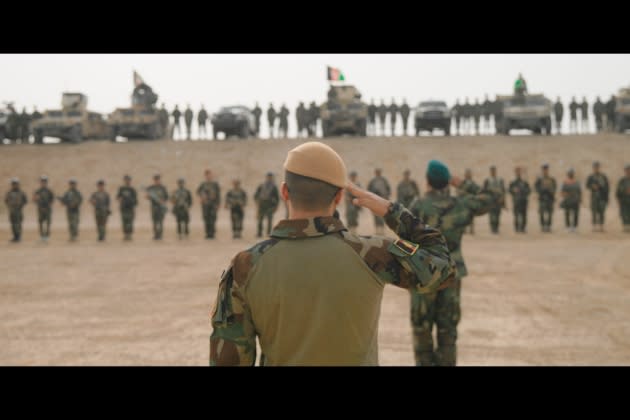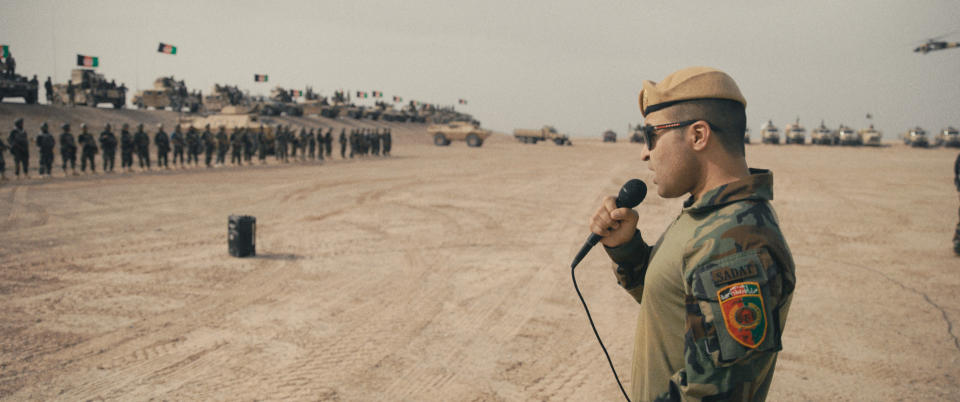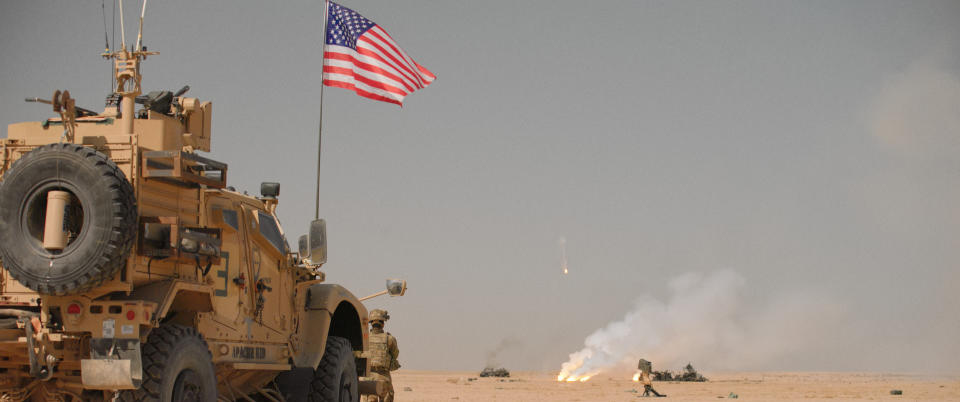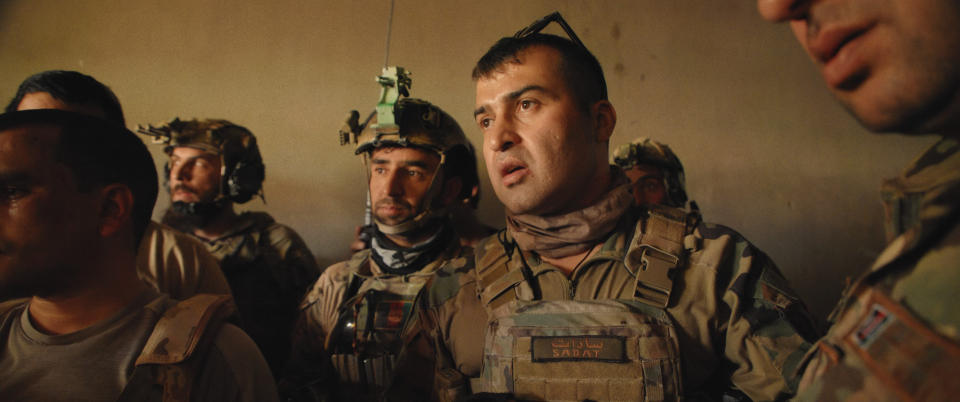Matthew Heineman Returns To Oscar Race With ‘Retrograde,’ Searing Doc On U.S. Military’s Last Months In Afghanistan, And What Happened Next
- Oops!Something went wrong.Please try again later.

In military parlance, the term retrograde can mean several things, among them withdrawal from a war zone, “where all or part of a deployed force voluntarily disengages from the enemy.”
The U.S. exit from the Vietnam War constituted a retrograde action, a chaotic process documented in Rory Kennedy’s Oscar-nominated film Last Days of Vietnam. A much more recent example came last year in Afghanistan, when U.S. forces were pulled from the battlefield after nearly 20 years of combat. The final months of America’s military intervention there—and what happened after the withdrawal—are documented in Retrograde, the new film from Matthew Heineman.
More from Deadline
In Oscar Contender 'The Flagmakers,' Immigrants And The Native-Born Stitch Together Old Glory
Box Office Hit And Oscar Contender 'Fire Of Love' To Get Limited Imax Release

Retrograde began streaming on Disney+ and Hulu over the weekend, after premiering on the National Geographic Channel on Thursday. It qualified for Oscar consideration with a limited theatrical release last month in New York, L.A. and other cities. Retrograde is the latest Oscar-contending documentary for the filmmaker, who launched his directing career in 2009.
“The bedrock of what I do is intimacy and access,” says Heineman, noted for his award-winning work in Cartel Land, City of Ghosts and The First Wave. The intimacy and access in Retrograde resulted from a tenacious effort to embed with U.S. Army Special Forces, better known as the Green Berets.

“Five or six years ago, I was pondering a somewhat clichéd question of why do we fight wars and began exploring different routes to examine that with the military–first with the Army Rangers, and then I got connected with my producing partner, Caitlin McNally. And she had a relationship with the Green Berets,” Heineman explains. “So, we ended up following that path. But it took years, really, to get permission both within the Green Beret community and ultimately at the highest levels of government and military to embed. It was the longest embed that they’d ever granted anybody in the Special Forces community.”
Heineman began filming with a dozen Green Berets deployed in Helmand Province, who were working closely with Afghan National Army troops under the command of Gen. Sami Sadat. As often happens among allies in war, the groups formed strong connections based on trust and loyalty, and they proved more successful than other parts of the Afghan National Army at repelling the Taliban.

Early in the film, Gen. Sadat says regarding his American comrades, “I can’t imagine them withdrawing from Afghanistan anytime soon,” a moment of optimism captured by Heineman. But on May 1, 2021 President Biden ordered that very withdrawal (presidents Trump and Obama before him had vowed to end U.S. military involvement in Afghanistan but didn’t follow through).
The film vividly conveys the feelings of the Green Berets and their Afghan allies after President Biden’s announcement.
“There’s a scene in the film where they tell their Afghan counterparts that they’re leaving. It’s quite a poignant scene where their faces all say more than words can ever say,” Heineman says. “That motif of faces was something that was very purposeful in the shooting of the film and the cutting of the film, really holding on faces for a really long time.”
He continues, “At the end of the day, the group of men I was with initially, the Green Berets, they felt like they were leaving behind and betraying a longstanding relationship. These are people that they’d fought alongside for, in some cases, decades, two decades. They’d lost many men together. So, there’s a real bond that was formed between the Americans and the Afghans.”
The withdrawal announcement forced Heineman to pivot from his original plan for the documentary.
“Two months into filming, Biden pulled our troops. And I was like, I don’t think I have a film,” he recalls. “I have a first act, I have a beginning. But the story’s definitely not over. So, I reached out to Gen. Sadat and asked him, ‘Would you be open to us coming back and embedding with you now?’ That’s when the lens of the film really shifted. Like most of the films I’ve made, they start out as one thing and they end up as something completely different.”

Heineman shows the process by which the Green Berets “retrograded” their equipment—burning documents, sledgehammering computers, dumping gasoline and detonating ordnance (one may wonder why U.S. forces didn’t turn over the explosives to the Afghan National Army, which presumably could have used them).
After the Green Berets departed, Heineman and his fellow cinematographers stayed behind, focusing on the Afghan forces’ attempt to keep the Taliban at bay.
“We were filming, especially with Gen. Sadat, as his country is crumbling around him,” Heineman observes. “He was in charge of 15,000 men and women, in charge of all southern Afghanistan. He basically had the world on his shoulders. He felt that if he lost Helmand, he would lose Afghanistan. Which was true.”

Heineman adds, “The film is many things. It’s a document of this moment in history, it’s an examination of war. But in another sense, it’s an examination of this leader, this man who, despite sort of every metaphorical neon sign saying, ‘Stop, give up, you’re going to lose,’ he failed to believe that. He had enormous faith that maybe, just maybe, if he succeeded, they could win this war up until the very end.”
The director does not see Retrograde as a political film.
“We have enough political rhetoric swirling around us at all times,” Heineman says. “There’s a reason why there is no politics in this movie. I believe deeply that by making films about human beings, about people, that it allows people from both sides of the aisle to enter into an issue that is so polarizing. To me, the whole point of film or documentary film is to elicit emotion and to create a dialogue. And, certainly, this is not an analysis of what happened or what went wrong.”
Some of the most emotionally fraught moments of the film come as the Taliban nears Kabul and desperate Afghan civilians converge on the airport in hopes of fleeing abroad. Heineman was right in the middle of crowds of people pleading to get onto final evacuation flights, their progress halted by U.S. military personnel who had returned to Kabul to oversee the evacuations.
“The opportunity became… to show the civilians that the Green Berets, that Gen. Sadat, had been fighting for,” Heineman notes. “We were able to open up the aperture of the film to see this sort of tragedy play out on a scale which I’ve never witnessed in my life. The scene at the Abbey Gate [at the Kabul airport] with thousands of Afghan civilians, [U.S.] and NATO partners crammed together in a four foot sewage ditch as 18-year-old Marines are making these Sophie’s Choice decisions of who to let in and not to let in–as the Taliban was watching at gunpoint a hundred yards away, as ISIS was circling around in a suicide vest waiting to attack, which happened 12 hours later at that very spot that I was filming in—all I could think about as tears were streaming down my face was, what have we done?”
He continues, “I’ve cried a lot, certainly in making these films… in the edit room, at screenings… I’ve never actually cried while filming. And in that moment, it was just unbearable to watch. Tears were streaming down my face, I was continually wiping my lens, which kept fogging up. It just was, ‘This is how it ends.’ And now we’re back to where we were 20 years ago. Girls can’t go to school. Women can’t walk outside without their faces covered. The economy is in freefall. It’s tragic.”
Best of Deadline
Sign up for Deadline's Newsletter. For the latest news, follow us on Facebook, Twitter, and Instagram.

